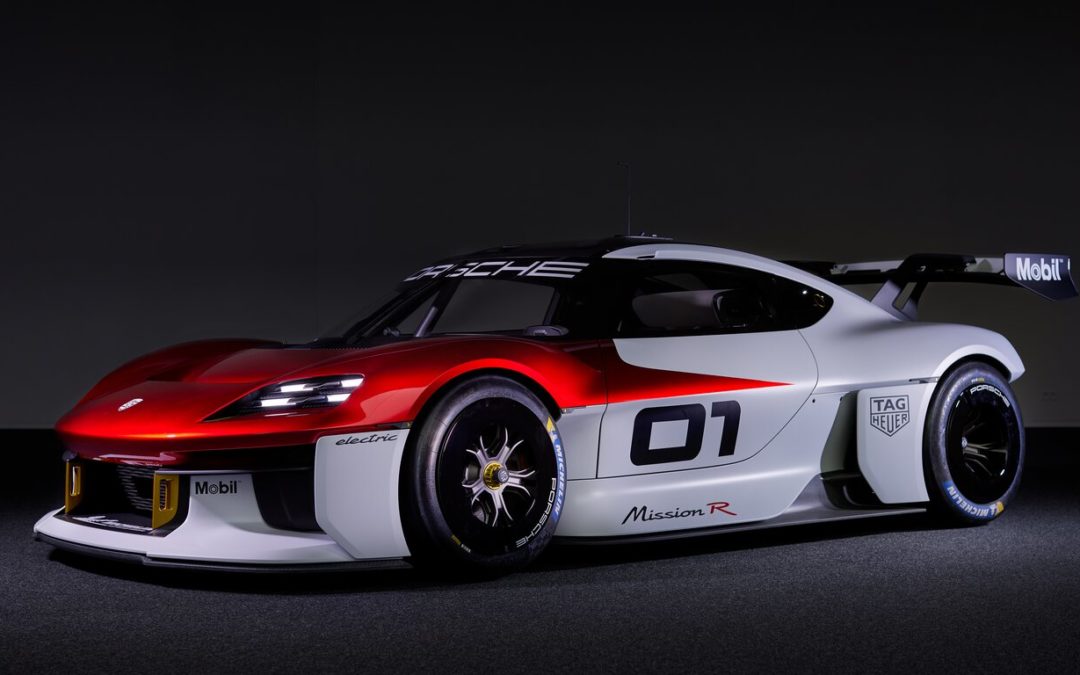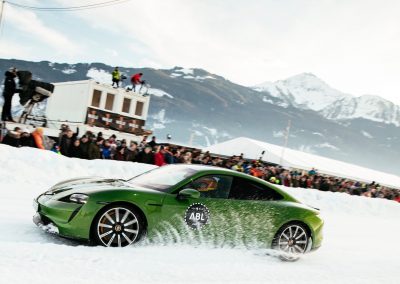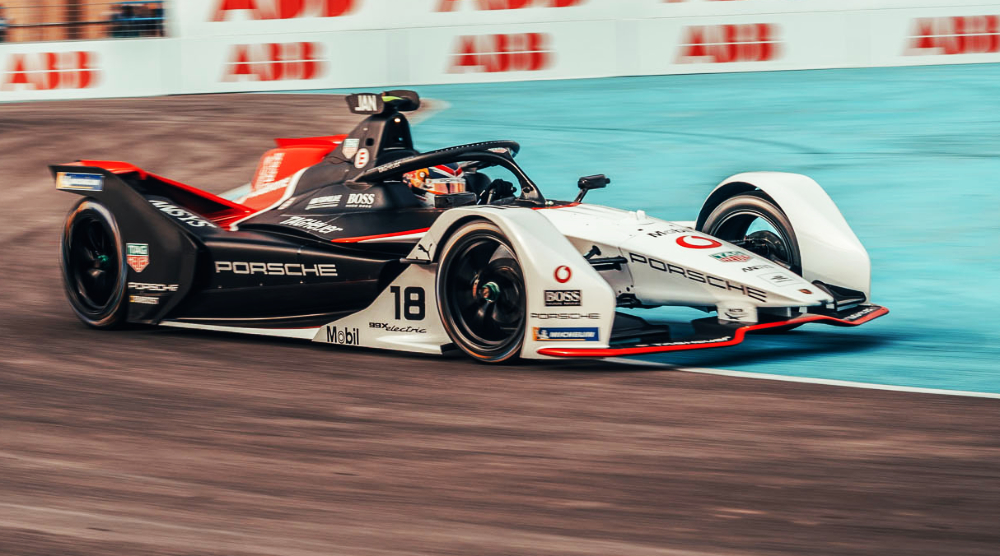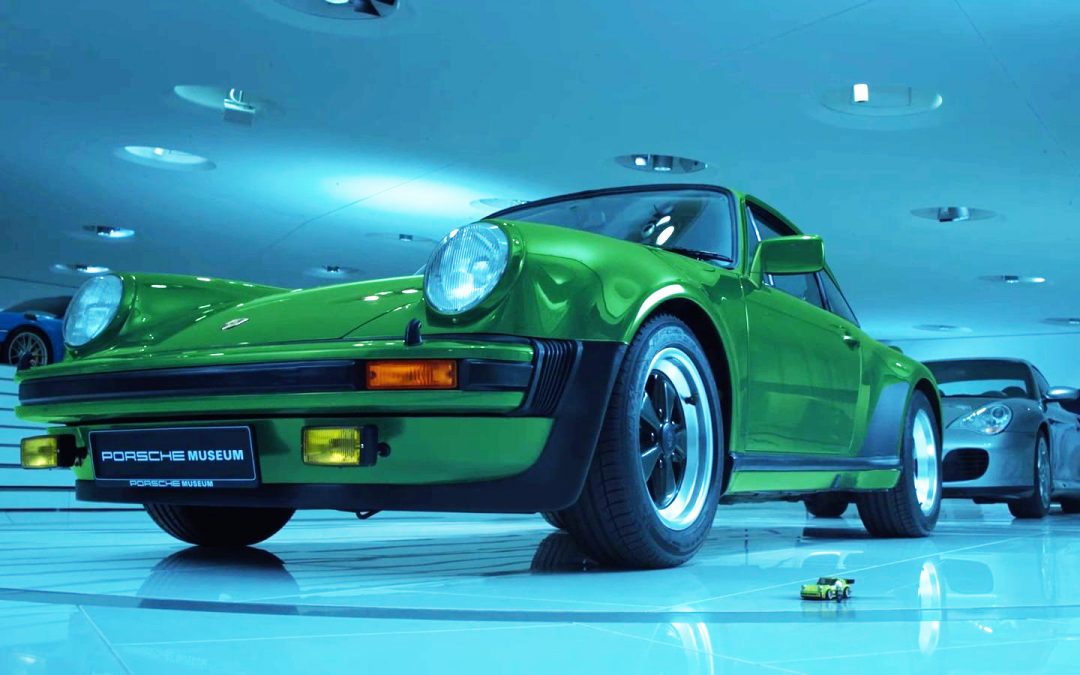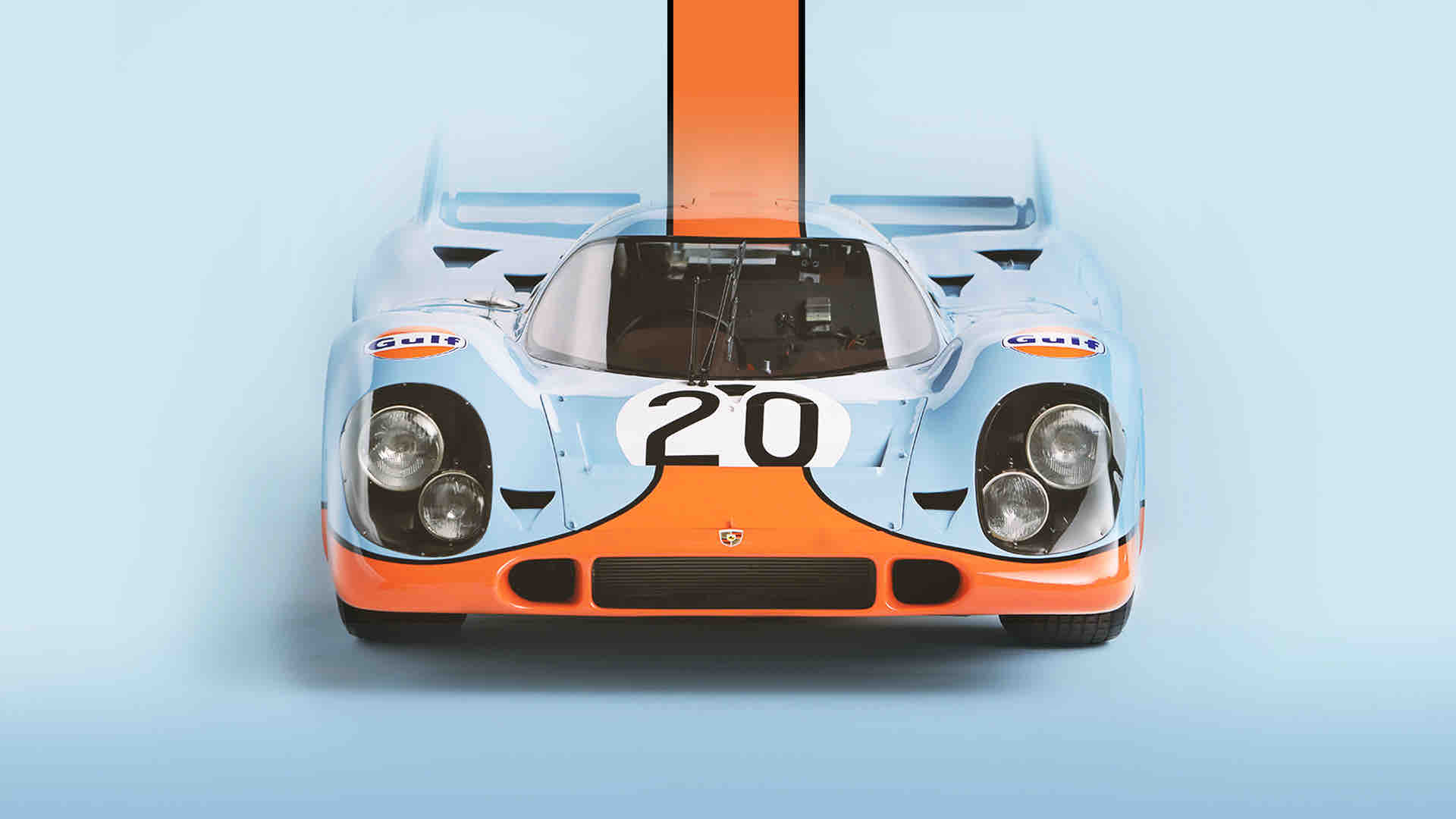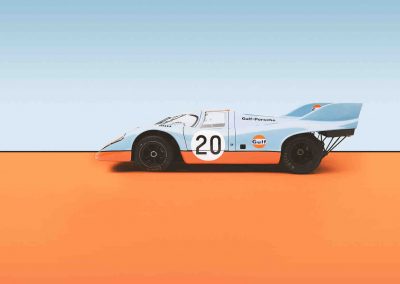
by Emmett Milazzo | Nov 22, 2021 | Motorsports
Performance: on a par with the Porsche 911 GT3 Cup
The electric all-wheel drive delivering over 800 kW (1,088 PS) in so-called qualifying mode takes the Mission R to a top speed of more than 300 km/h. The power output remains constant, so there is no thermally induced derating – a major benefit of using the electric motors with direct oil cooling developed at Porsche. The electric motor on the front axle develops as much as 320 kW (435 PS) in racing mode, while the motor on the rear axle produces a maximum of 480 kW (653 PS). The all-electric racing car, which weighs in at around 1,500 kilograms, accelerates from zero to 100 km/h in less than 2.5 seconds.
Design: unique “exoskeleton” cage structure and driver cell doubles as a simulator
“Every Porsche has to be clearly recognisable as a Porsche. Many elements that we envisage in studies find their way later into production cars. This also applies to motorsports. Moreover, our customer sports vehicles are always based on production sports cars,” explains Michael Mauer, Head of Style Porsche. “What this means in the case of the Mission R is that the car is packed to the gills with signs that hint of a future production model, and that, of course, means: pure racing! “
The Mission R features the typical racing design of the marque and is future driven at the same time. At first glance, the extreme compactness is very apparent: it has a length of 4,326 millimetres and a width of 1,990 millimetres. Typical of racing cars, the electric racer sits very low on the road (height: 1,190 millimetres). The wheelbase: 2,560 millimetres. The narrowly shaped cabin reduces the frontal area of the racing car and contributes to the outstanding e-performance due to the lower air resistance.
The exoskeleton is the name Porsche engineers and designers have given the Mission R’s eye-catching carbon cage. The carbon fibre composite cage structure combines high protection potential for the driver with low weight and a distinctive look.
The protective structure forms the roof section and is visible from the outside. Like a half-timbered construction, it provides a framework around six transparent segments made of polycarbonate. This means that racing drivers can now enjoy a new feeling of generous space. There are also some transparent surfaces, including a removable escape hatch for the driver, which is based on the FIA requirements for racing vehicles used in international competitions.
Genuine motorsports and esports merge in the Mission R. This is due to its monocoque type driver cell that is designed as a self-contained module and can be used in exactly the same form outside the vehicle as a simulator. This allows the racing driver to prepare for his next race virtually in a familiar environment. It also means that the racing drivers of tomorrow can also take part in esports events.

by Porsche411 | Nov 22, 2021 | Mid-Engine, Motorsports
Porsche has revealed the new 718 Cayman GT4 RS Clubsport at the Los Angeles Auto Show. The mid-engine race car from Weissach is based on the new, and recently revealed, 718 Cayman GT4 RS road car.
As with its road-going sibling, the new 718 Cayman GT4 RS Clubsport is equipped with a mighty 4.0 liter six-cylinder boxer engine. This high-revving power plant is taken directly from the 911 GT3 Cup race car and develops 500 hp in the 718 Cayman GT4 RS Clubsport – 75 hp more than the previous GT4 Clubsport model.
Fitted as standard is a seven-speed dual-clutch transmission (PDK), replacing the GT4 Clubsport’s six-speed version. All gears feature shorter ratios than on the GT4 Clubsport.
The homologated 718 Cayman GT4 RS Clubsport is track-ready from the factory and can be used in SRO racing series around the world without further modifications. The starting price of the new 718 Cayman GT4 RS Clubsport, which will be sold and distributed through Porsche Motorsport North America in the U.S., is $229,000, not including tax.
“We thrive on competition, and will always push for improvements,” said Volker Holzmeyer, President and CEO of Porsche Motorsport North America. “This is what our customer teams expect of us and what we demand of ourselves at Porsche. Acting on their feedback, we’ve made the new 718 Cayman GT4 RS Clubsport more capable than ever. It’s quicker, even more rewarding and confidence inspiring to drive – exactly what drivers competing in the IMSA Michelin Pilot Challenge and SRO series need to be successful.“
Porsche began offering the Cayman GT4 Clubsport of the 981 generation in 2016, entering into this new customer racing format early with a competitive car, and 421 units were built up to 2018. In 2019, the next generation model debuted based on the 718 Cayman GT4. It was also a success: Around 500 units have been produced to date. The strong demand for these vehicles is also due to the low running costs. The use of proven series production technology combined with racing-specific components reduces the cost for customer teams.
“The GT4 Clubsport has a special place in my heart,” adds Holzmeyer. “As I’ve been deeply involved with the car from the start, ever since it first began development. Therefore, it’s also a personal ambition for me to continuously improve it, to make it better and better.”
The 718 Cayman GT4 RS Clubsport in detail
The 500 hp 4.0 liter six-cylinder boxer engine is taken directly from the current 911 GT3 Cup racing car and is 18 percent more powerful than the 3.8 liter engine used in the previous model – the 718 GT4 Clubsport. Thanks to an optimized air intake, maximum power is achieved at 8,300 rpm – 800 rpm higher than previously. The new engine can rev up to 9,000 rpm and develops 343 lb.-ft. at 6,000 rpm, while the previous engine generated 313 lb.-ft. at 6,600 rpm. The result is a much wider, more usable power band of the new engine, improving the drivability of the car for pro-racers as well as amateur drivers alike.
The suspension of the 718 Cayman GT4 RS Clubsport was also extensively enhanced. The damper technology was revised from the ground up to offer an optimized responsiveness and a further improvement in body control, making a significant impact on track performance and handling. Two-way racing adjustable shock absorbers with further improved valve characteristics as well as adjustable double-blade anti-roll bars, front and rear, are among the updates. Ride height, camber and toe are also adjustable. Additionally, three different spring rates for front and rear axle are available. Special NACA ducts in the front lid feed air efficiently to the large race braking system with 380 mm multi-piece rotors that are vented and slotted. The Porsche Stability Management-System (PSM) is programmed specifically for the track and includes a switch for traction control, ABS and an updated stability control programming.
The aerodynamics of the 718 Cayman GT4 RS Clubsport have also been enhanced in great detail. Front dive planes as well as an enlarged front spoiler lip increase downforce at the front axle. Fender vents inspired by the 911 GT3 R and special air curtains calm the air flow around the front wheels, while the enclosed underbody optimizes air flow to the diffusor at the rear of the car. The swan neck rear wing has been fitted with a 20 millimeter long Gurney flap and gains two further stages of adjustability.
The previous 718 Cayman GT4 Clubsport was the first series production race car to use body panels made of sustainable natural fiber composites. This material is being used even more extensively on the new GT4 RS Clubsport. In addition to the doors and the rear wing, the front lid, fenders, aerodynamic components at the front and the steering wheel consist of this material. The use of this flax-based fiber as an alternative to carbon-fiber composite can be tested in racing for a potential future use in road cars. Porsche has been using motorsport as a test bed for technology, processes and materials potentially capable of being used in road cars for more than 70 years.
The 718 Cayman GT4 RS Clubsport is equipped to compete straight out of the box. This begins with the welded-in roll cage, as well as the longitudinally-adjustable Recaro racing seat, and extends to six-point harnesses with 2023 FIA standard, all the way to the fire extinguisher system and built-in air jack system with three jacks. The new foam on the driver’s side meets the international requirements of the SRO racing series. The FT3 fuel cell can accommodate up to 115 liters (30.4 gallons) of fuel, making it suitable for endurance racing. Additionally, Porsche offers two different exhaust systems, allowing the GT4 RS Clubsport to compete at tracks with stricter noise limits. Special Fitment preparations for homologated additional headlights or openings in the front lid for quick refueling allow a quick conversion to suit nighttime endurance racing.
Racing fans in the U.S. can look forward to seeing the car compete in the IMSA Michelin Pilot Challenge and the SRO GT4 America and GT America series in the 2022 U.S. season. Interested customers can contact Porsche Motorsport North America at info@porschemotorsport.com.

by Porsche411 | Dec 16, 2020 | Etcetera, Mid-Engine, Motorsports
The Executive Board at Porsche AG has given the green light to the development of an LMDh prototype. After a lengthy evaluation phase, Porsche Motorsport received the order to build a vehicle based on future regulations. From 2023, the LMDh cars will make up a new top class in the FIA World Endurance Championship (WEC) and the North American IMSA WeatherTech SportsCar Championship. Both championships are hugely significant for the Stuttgart sports car manufacturer. Porsche very much welcomed the introduction of the new class for hybrid prototypes when it was jointly announced by the organizers at ACO/WEC and IMSA.
OFFICIAL PORSCHE VIDEO:
The racing cars, which tip the scales at around 1,000 kilograms, are powered by a hybrid system with an output of 500 kW (680 hp). “The new LMDh category allows us to fight for overall victories with a hybrid system at the Le Mans, Daytona and Sebring classics – without breaking the bank. The project is extremely attractive for Porsche. Endurance racing is part of our brand’s DNA,” explains Oliver Blume, CEO at Porsche AG. For the first time in more than 20 years, it will be possible to fight for overall victories with identical vehicles at endurance races around the world. Moreover, the new LMDh category focuses on high cost-efficiency. The cars are based on an upgraded LMP2 chassis, and the spec for the hybrid system including the control electronics is standardized. Chassis from four different manufacturers are available. Each brand is free to select the concept for the combustion engine and the body design within the framework of the regulations.
Michael Steiner, Board Member for Research and Development at Porsche AG, adds: “In the medium term, Porsche focuses on three different drive concepts: fully electric vehicles, efficient plug-in hybrids and emotional combustion engines. We want to represent this trilogy in both the development of our cutting-edge road cars and in motorsport. We use the all-electric drive to contest the FIA Formula E as part of our works commitment, and the highly efficient and emotional combustion unit in GT racing. Now, the LMDh class closes the gap for us. There, powerful hybrid drives – like the ones that are mounted in many of our brand’s models – go up against each other. If the regulations eventually allowed the use of synthetic fuels, then that would be an even greater incentive for me in terms of sustainability.”
“I’d like to thank our board of directors for the immense confidence they have in the motorsport strategy we’ve developed,” explains Fritz Enzinger, Vice President Motorsport. “We hold a record with our 19 outright wins at the 24 Hours of Le Mans and we’ve climbed to the top podium step many times at major races in the USA. We can continue this tradition with an LMDh vehicle while at the same time keeping costs reasonable. There has been huge interest from other manufacturers. I hope we can pick up where we left off with the famous clashes against many other marques in the eighties and nineties. That would give the entire motor racing scene a huge boost.”
High-performance hybrid drives have enjoyed a long and extremely successful tradition at Porsche Motorsport. In 2010 and 2011, the revolutionary Porsche 911 GT3 R Hybrid set new benchmarks at races on the Nürburgring-Nordschleife. At that time, there was no other comparable vehicle with a hybrid drive. Between 2014 and 2017, the sports car manufacturer from Stuttgart underlined its expertise in the field of highly efficient, high-performance hybrid drives with the 919 Hybrid. In the FIA World Endurance Championship (WEC), the LMP1 class prototype achieved a hat trick, winning three times in a row at the Le Mans 24-hour classic. Porsche also clinched the manufacturers’ and drivers’ championship titles three times straight.

by Porsche411 | Feb 6, 2020 | 911/912, Mid-Engine, Motorsports, Sedans / SUVs, Vintage
While many Porsche owners around the world lock their cars away when winter arrives, some brave owners go ice racing!
On a track built on top of thick ice, interesting and historically significant cars slipped and slithered and raced their way into the history books. Many, in the controlled environment of the race track, towed ski racers behind them in a renaissance of the lost art of skijöring. Two Porsche brand ambassadors were among them: LeMans driver Jörg Bergmeister had the Norwegian Olympic ski champion Aksel Lund Svindal in tow.
Watching the 16,000-strong crowd is almost as fascinating as watching the cars at the GP Ice Race, with a real mixture of people mingling in a shared enthusiasm for all things four-wheeled.
The GP Ice Race is like a Goodwood on Ice. In terms of numbers of cars and guests, there are many similarities to when the Goodwood Festival of Speed first started in 1993, but it is aimed at a new generation of motor racing fans for whom the party and the social media moments are as important as who finished which race in what position.
More Info: https://www.gpicerace.com/

by Porsche411 | Jan 27, 2020 | 911/912, Motorsports
The new Porsche 911 RSR-19 celebrated a successful North American race debut in the IMSA WeatherTech SportsCar Championship, January 25 – 26, with a double podium finish at the Rolex 24 At Daytona. After a strong team effort, the two ca. 515-hp Porsche 911 RSR-19 fielded by the Porsche GT Team finished in second and third-places of the GTLM class. In the GTD class, Porsche 911 GT3 R customer teams finished in fourth, fifth and 13th-places.
From start to finish, the factory GT racers from Germany ran like clockwork at their first 24-hour race. Not a single technical problem hampered the premiere as the two new 911 RSR-19 race machines took turns in the lead over most of the record distance. After 786 laps, Porsche was just shy of claiming a record-extending victory at the 24-hour classic in Daytona Beach, Florida.
The two Porsche 911 RSR-19 had already turned heads earlier in the weekend at the high-speed oval/road course combination track. The “works” cars swept the first-two positions on the GTLM class grid in qualifying with Nick Tandy (Great Britain) charging the No. 911 to the pole position just ahead of teammate and defending IMSA Champion Laurens Vanthoor (Belgium) in the No. 912. In the race, Vanthoor, Earl Bamber (New Zealand) and Mathieu Jaminet (France) followed on this performance, claiming second-place in the No. 912 race car, with the No. 911 sister car with the driver trio of Tandy, Frédéric Makowiecki (France), and Matt Campbell (Australia) finishing in third-place. With flawless stints, a perfect strategy and swift pit stops, both crews set the pace at the front.
The Porsche customer teams also put in a strong performance at the season-opening round of the 2020 race season. Wright Motorsports with Porsche factory driver Patrick Long (Manhattan Beach, California), Ryan Hardwick (Atlanta, Georgia), Anthony Imperato (Brooklyn, New York) and Austrian Klaus Bachler made a dramatic comeback in the second half of the race, managing a fourth-place finish in the GTD class despite sustaining slight damages to the underbody of their No. 16 Porsche 911 GT3 R. Behind them, Black Swan Racing also put in a spirited chase through the field to take fifth-place with drivers Sven Müller (Germany), Jeroen Bleekemolen (Netherlands), Timothy Pappas (Boston, Massachusetts) and Trenton Estep (San Antonio, Texas) at the wheel of the No. 54 entry. The team, with the assistance of Porsche Motorsport North America (PMNA) and Wright Motorsports, made the race start after a serious accident rendered the originally entered Black Swan Porsche 911 GT3 R un-repairable on-site. The end result was a impressive example of teamwork, tenacity and the Porsche “Family” spirit.
The GTD class pole-winning Porsche 911 GT3 R of Pfaff Motorsports experienced a frustrating ending to a strong weekend. After leading the pro-am style class for the majority of the first 12-hours, a drive-shaft defect relegated the No. 9 car shared by factory ace Patrick Pilet (France), Dennis Olsen (Norway), 2019 IMSA Sprint Cup Champion Zach Robichon (Canada) and Porsche Development Driver Lars Kern (Germany) down through the field. The quartet ultimately crossed the finish line in 13th-place.
Pascal Zurlinden, Director GT Works Motorsport.
“That was a perfect debut for the new Porsche 911 RSR. At the first race in the USA – and one over 24 hours – we didn’t experience a single technical problem and ended up on the podium with both cars. From the team effort to the strategy right through to the work in the pit lane, everything ran smoothly and flawlessly. At the next race in Sebring, we want to defend our victory from last year.”
Nick Tandy, Driver, No. 911 Porsche GT Team Porsche 911 RSR-19.
“It’s not often that you make it through a 24-hour race without making any mistakes. It’s remarkable and a great start to the season for the new 911 RSR. Even though it wasn’t quite enough today, we’re all the more determined to go all-out and climb to the top step of the podium again in the future.”
Frédéric Makowiecki, Driver, No. 911 Porsche GT Team Porsche 911 RSR-19.
“It was a clean race that we can be proud of. The car ran well from start to finish. Our pit crew did an awesome job. There’s nothing to improve on. Our pace was good, too, but in the end it wasn’t quite enough to win.”
Matt Campbell, Driver, No. 911 Porsche GT Team Porsche 911 RSR-19.
“We pushed hard right from the start, stayed amongst the frontrunners for 24 hours and led for a long time. To kick off the season on the podium with the two new RSR is a fantastic start to the 2020 racing year.”
Earl Bamber, Driver, No. 912 Porsche GT Team Porsche 911 RSR-19.
“We fought to the finish and tried everything. Our car ran excellently. However, one of our rivals was slightly faster. I’m still very proud, because the team worked brilliantly together and after 24 hours we’re on the podium with the two new Porsche 911 RSR.”
Mathieu Jaminet, Driver, No. 912 Porsche GT Team Porsche 911 RSR-19.
“I have mixed feelings after this race about whether I should be happy or not with second-place. We drove a perfect race and maintained a steady pace supported by a highly motivated team. But the competition was a little better and you have to acknowledge that.”
Laurens Vanthoor, Driver, No. 912 Porsche GT Team Porsche 911 RSR.
“We had our eye on winning, but unfortunately it wasn’t quite enough. I can’t say what we did wrong. The new RSR ran beautifully, the team and drivers did a great job. I just have to come back next year to finally try to win at Daytona after my successes at Le Mans, Spa-Francorchamps and the 24-hour race at the Nürburgring.”
Patrick Long, Driver, No. 16 Wright Motorsports Porsche 911 GT3 R.
“I’m actually quite satisfied with the race. We constantly had to catch up, but we did this very well as a team with the right pit-stop strategy. Towards the end of the race, we lacked the pace compared to the three competitors in front of us. All in all, it was a good start to the season for our team.”

by Porsche411 | Jan 25, 2020 | 911/912, Motorsports
IMSA WeatherTech SportsCar Championship: The new Porsche 911 RSR has made an impressive North American debut in qualifying for the 24-hour race at Daytona by claiming positions one and two on the grid. During the 15-minute session on the Daytona International Speedway, Nick Tandy in the No. 911 vehicle and Laurens Vanthoor in the No. 912 sister car fought a heated duel for the fastest lap time.
Nick Tandy (Great Britain) and Belgium’s Laurens Vanthoor tapped the full potential of the 2019-generation GT racer, which is based on the high-performance 911 GT3 RS road-legal sports car, and swapped places at the top of the time sheets. In the end, Tandy snatched pole position with a time of 1:42.207 minutes ahead of Vanthoor, thus beating his own GTLM-class qualifying record, which he set at Daytona in 2019.
Complete event details, broadcast schedule, live timing, and updates can be found here:
https://www.imsa.com/events/2020-rolex-24-daytona

by Porsche411 | Jan 10, 2020 | Mid-Engine, Motorsports
A film team spent several months accompanying the TAG Heuer Porsche Formula E Team on its road to the first fully-electric racing series in the world. The 26-minute video not only reviews the most important milestones and the successful debut at the Diriyah E-Prix in Riyadh (Saudi Arabia), but also offers viewers new and exclusive insights into the world of Porsche Motorsport.
“Porsche has enjoyed countless successes at racetracks around the world, not least at the legendary 24 Hours of Le Mans. As such, we have high expectations of ourselves,” says Amiel Lindesay, Head of Operations for the TAG Heuer Porsche Formula E Team. “Following intense preparations, we have now arrived in the first fully-electric racing series and are also playing a significant role in shaping the future of motorsport in this environment,” says regular driver André Lotterer. “In doing so, we are learning all the time,” adds team-mate Neel Jani. “Particularly when we go up against the opposition.”
Success in the ABB FIA Formula E Championship is not only important for motorsport. Porsche introduces innovations from the racetrack into its production operations. Findings from motorsport always have a significant influence on the sports cars of tomorrow. “Porsche sees itself as a pioneer in sustainable sporty mobility,” explains Malte Huneke, Technical Project Leader with the TAG Heuer Porsche Formula E Team: “Battery-powered cars are currently the central issue in the automobile industry, with the goal being to reduce CO2 emissions. We are already on our way to achieving that goal.”

by Porsche411 | Jan 8, 2020 | 911/912, Etcetera, Motorsports, Vintage
The Lego Speed Champions Porsche 911 RSR and Porsche 911 Turbo 3.0 Building Kit is really fun to build. When the cars come alive inside the Stuttgart Porsche Museum it gets even better. There are a ton of great vintage and racing Porsches to see when you take the video tour of the museum at night with these adventurous mini-figures…just keep an eye out for the law…

by Porsche411 | Dec 31, 2019 | Motorsports, Vintage
Colorful stickers and paintwork are as much a part of Porsche Motorsport as the boxer engine. In the latest episode of the Porsche Top 5 series, the company looks back on five historical color combinations of the various 917 models.
917-001 with green and white color scheme
The car with the body number 917-001 was a demonstration car completed just two days before the Geneva Motor Show. To mark the 50th anniversary of the 917, cutting-edge 3D technology was used to restore this model to its original condition, complete with the green and white color scheme.
917/20 “The Pink Pig”
Better known under the nickname “The Pink Pig”, the racing car is more than 24 centimeters wider and underwent further modifications to improve aerodynamics. The reworked body inspired the designers in 1971 to give the car a pink finish and apply markings that show cuts of meat.
917 “long-tail” with Martini livery
One year earlier this racing car – at that time still bearing a psychedelic green and purple stripe pattern – retired due to engine failure. Unfortunately, it was unable to cover the full distance on the Sarthe circuit in the following year either. Nevertheless, this 917 model was the first racing car to set a record average speed of over 240 km/h at Le Mans.
917 in Gulf livery
The light blue and orange finish became famous mainly due to its appearance in the Steve McQueen film “Le Mans”: to this day it has remained one of the most valuable models.
917 in Salzburg Red
Based on the colors of the Austrian flag, this racing car clinched its very first overall victory for Porsche at the 24 Hours of Le Mans in 1970.
